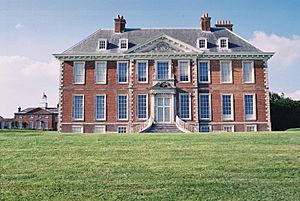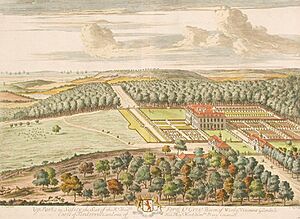Uppark facts for kids
Quick facts for kids Uppark |
|
|---|---|

The south front of the house
|
|
| Type | Country house |
| Location | South Harting |
| OS grid reference | SU 77981 17583 |
| Area | West Sussex |
| Built | ca 1690 |
| Architect | William Talman Humphry Repton |
| Architectural style(s) | William & Mary |
| Owner | National Trust |
|
Listed Building – Grade I
|
|
| Official name: Uppark (National Trust) | |
| Designated | 18 Jun 1959 |
| Reference no. | 1025979 |
| Lua error in Module:Location_map at line 420: attempt to index field 'wikibase' (a nil value). | |
Uppark is a beautiful country house built in the 1600s. It is located in South Harting, West Sussex, England. This historic house is protected as a Grade I listed building. Today, it is owned by the National Trust, a charity that looks after special places.
Contents
History of Uppark House
Uppark House sits high up on the South Downs. It was built around 1690 for Ford Grey, 1st Earl of Tankerville. The person who designed it was likely William Talman.
New Owners and Grand Tours
In 1747, the Uppark estate was sold to Sir Matthew Fetherstonhaugh and his wife, Sarah. They spent many years, from 1750 to 1760, redecorating the house. They also brought in many of the amazing items you can see there today. Most of these treasures were collected during their "Grand Tour" of Europe between 1749 and 1751.
Their only son, Sir Henry Fetherstonhaugh, added even more to the collection. He hired Humphry Repton to design a new entrance with pillars, a dairy, and a beautiful landscaped garden. Later, in the 1800s, separate buildings for stables and kitchens were added. These were connected to the main house by underground tunnels.
A Special Marriage and Legacy
When he was 71, Sir Harry married Mary Ann Bullock, who was the estate's dairymaid and only 21. When he passed away in 1846, he left Uppark to her. Mary Ann made many improvements to the house. After she passed away in 1874, she left Uppark to her sister, Frances.
Frances Bullock, who used the name Miss Fetherstonhaugh, wanted to keep the house special. She chose two friends, Colonel Keith Turnour and Admiral Herbert Meade, to inherit it after her. Both men took on the Fetherstonhaugh name. Admiral Meade's wife, Margaret, became the next mistress of Uppark in 1931. She continued to care for the house and its contents.
Becoming a National Trust Property
After World War II, Admiral Meade-Fetherstonhaugh and his son, Richard, talked with the National Trust. As a result, Uppark became part of the National Trust in 1954. The house is now open for everyone to visit. However, some parts are still used as private homes, leased from the Trust.
H. G. Wells' Connection to Uppark
The famous writer H. G. Wells spent time at Uppark when he was 20 years old. This was in the winter of 1887-1888. His mother, Sarah, worked as the housekeeper at Uppark from 1880 to 1893. She had also worked there earlier, from 1850 to 1855, as a housemaid. H. G. Wells visited her many times when he was a boy. His father, Joseph, who was a gardener, also worked at Uppark in 1851. His parents married in 1853.
How Uppark Shaped a Writer
The house and its way of life greatly influenced H. G. Wells. He saw clear differences between social classes there. These observations helped him develop his ideas about fairness and equality. He also found many books in Uppark's large library. He read works by thinkers like Plato, Voltaire, and Thomas Paine.
These experiences appeared in his later books. For example, in The Time Machine, the bright world of the Eloi and the dark caves of the Morlocks are thought to be inspired by the social differences he saw at Uppark. Wells also found a telescope in the house's attic. This gave the future author of The War of the Worlds his first chance to look closely at the night sky.
The Uppark Fire and Restoration
The Fire of 1989
On August 30, 1989, a terrible fire badly damaged Uppark. It was caused by a workman's blowtorch while he was fixing the roof. This happened just two days before the repair work was supposed to finish. The fire started while the house was open to visitors.
Many valuable artworks and pieces of furniture were quickly carried out of the burning building. Family members, National Trust staff, and even visitors helped save these items. The top floors collapsed, and everything on those floors was lost. However, the floors mostly fell away from the ground-floor walls. This meant much of the wall panels and decorations on the ground floor survived.
Saving and Rebuilding Uppark
Many items on the ground floor were crushed but not burned. Metal objects could be straightened and cleaned. Crystal chandeliers were put back together. Even the fancy tassels on the chandelier ropes were saved. It was decided to restore the house because it would cost less than paying for a total loss through insurance.
Most of the paintings and furniture in the house were saved. The building has been completely restored since the fire. Many old crafting skills had to be relearned during the restoration. Uppark reopened its doors to the public in 1995. You can still see some "critical markers" today, like burn marks on some ground-floor boards. These remind visitors of the fire's history.
Visiting Uppark
Uppark is open to the public on most days of the year. It is usually closed only around Christmas.



